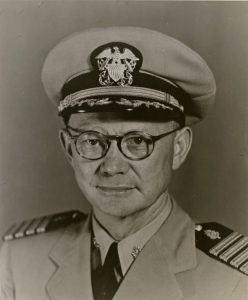By André B. Sobocinski, historian, U.S. Navy Bureau of Medicine and Surgery
Part II: The Naval School of Aviation Medicine and the Human Disorientation Device
“You tumbled slowly, twisted and rolled as your body lurched against the tight harness that strapped you to a couch. Then you rotated faster and faster until finally you were spinning violently in three different directions at once—head over heels, round and round as if you were on a merry-go-round, and sideways as if your arms and legs were tied to the spokes of a wheel. It was a wild and sickening sensation. Your vision blurred. Your forehead broke out into a cold, clammy sweat…[and] you could get sick enough to vomit.”
~Virgil I. (Gus) Grissom on Human Disorientation Training, We Seven, 1962

From 1959 until the launch of Alan Shepard’s Freedom 7 capsule in May 1961, the Mercury Seven went through an almost continuous regimen of training and medical tests to prepare them for spaceflight. Gus Grissom would later quip that the Mercury Seven moved so fast from one training facility to another that in some cases they “outran” the people who were training them.
The schedule of America’s first astronauts may have been “disorienting” at times; it could also be said that on occasion their training was designed to be so. This certainly was the case in 1959 when they went through the Naval School of Aviation Medicine in Pensacola, Florida.
The Naval School of Aviation Medicine, later known as the Naval Aerospace Medical Institute (NAMI), has historically been responsible for ensuring physical standards and qualifications of pilots and training aviation medical personnel for operational assignments. For the first decades of its existence (1939-1970), NAMI also operated an extensive basic and applied research laboratory.

Under the leadership of legendary aerospace medical researcher Capt. Ashton Graybiel, MC, USN (1902-1995), NAMI’s research component explored the effects of fatigue, vestibular physiology, neurological science, cosmic radiation and cardiovascular fitness, all of which would prove invaluable for the first manned space flights. NAMI operated special laboratories for researching spectroscopy, nuclear admission, low-level alpha radiation, medical electronics, ballisto-cardiography and bioacoustics/psychoacoustics. But NAMI also housed two large training devices that set it apart from other aerospace research laboratories.
NAMI’s human disorientation device (HDD) and “slow rotation room” were both designed for studying human-performance in motion-based environments and, ultimately, for learning adaptation techniques, training procedures and how drugs could reduce symptoms of disorientation.
First constructed in the 1958 at a cost of $1 million, the HDD was once described in LIFE Magazine as looking like an “automatic cocktail shaker.” The HDD was a large aluminum cylinder that contained a standard pilot seat and a doorway or trapdoor. Test subjects would be strapped into the device and rotated vertically and horizontally to induce vertigo.

As its name implied, NAMI’s slow rotation room simulated “slowly rotating artificial gravitational environments.” Constructed in a plywood room 15 feet in diameter and 10 feet high with padded walls, the room contained two automobile seats that faced instrument dials, an electric stove, shelves stocked with canned goods and books and a number of testing devices (e.g, trashcan for throwing tennis balls into while the room rotated). The slow moving room could be programmed to rotate at variable speeds for and durations. Test subjects could stay in the room from hours to days.
NAMI would continue to collaborate with NASA well beyond Project Mercury. Its research laboratory was later designated as the Naval Aerospace Medical Research Laboratory (NAMRL) in 1970; four years later, it would become a separate command. It 2011, NAMRL relocated from Pensacola to Wright-Patterson Air Force Base, Ohio and was renamed the Naval Medical Research Unit (NAMRU)-Dayton. Today NAMRU-Dayton continues on the proud tradition of its forebear.
This is part two of a four part series. Stay tuned for part three featuring the Mercury Seven and the Naval Medical Research Institue.
Previous installments of “Supporting the “The Right Stuff”: Looking Back at the Navy Medical Department and the Mercury Space Program”:
 Navy Medicine World Class Care… Anytime, Anywhere
Navy Medicine World Class Care… Anytime, Anywhere






Airline in Malaysia
Jordanian Airlines